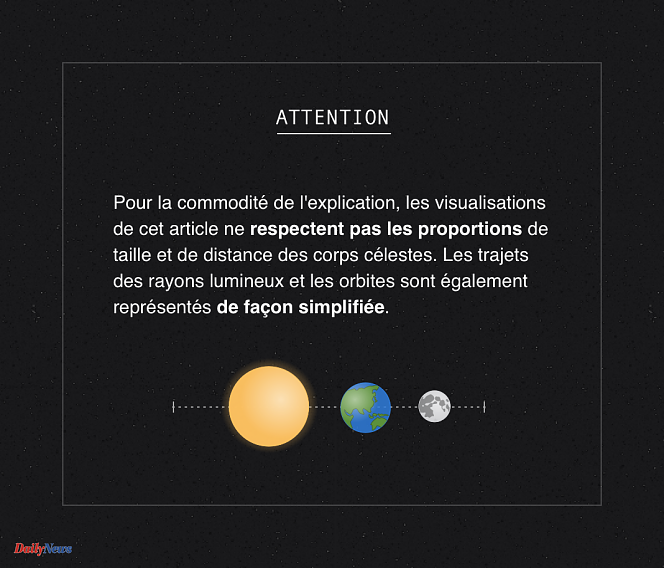Eclipses, almost anyone could explain it to you, occur when the Moon, Earth and Sun align and our planet and its companion cast their shadows on each other:
Solar eclipses
Three types of solar eclipses can be observed:
They occur when the entire solar disk is obscured by the Moon. When this happens, the Moon is at exactly the right distance to appear the same size as the Sun: it is then 400 times closer to Earth than the Sun, but also 400 times smaller. The moment when the Moon perfectly obscures the Sun is called “totality” and can last up to seven minutes.
Minutes during which we can observe the atmosphere of our star: the chromosphere (lower atmosphere) and the solar corona (upper atmosphere, scattered over several million kilometers). This spectacle can be observed with the naked eye without danger, unlike the preceding moments and following totality, during which the sun's rays (especially ultraviolet and infrared) are still just as dangerous for the eyes, despite the drop in brightness of the Sun, and can cause irreversible eye damage. Be careful, therefore, to wear suitable protective glasses.
They occur when the Moon only partially obscures the Sun, passing a little too high or low in relation to it.
They occur when the Moon is too far from Earth to completely obscure the Sun, leaving a ring of light visible around the Moon. They are slightly more numerous than total eclipses, because the Moon is often a little too far from Earth.
Lunar eclipses
Much less known because they are less spectacular, lunar eclipses can be much longer than solar eclipses because the shadow of the Earth, into which the Moon enters, is much wider. As the Moon is currently close to the farthest point of its orbit (called apogee), its speed of movement in its orbit is slower, which means that on July 27, it should remain in the Earth's shadow for about a hundred three minutes according to astronomers' calculations, not far from the theoretical maximum duration (107 minutes).
Just like its solar counterpart, the lunar eclipse can be observed in three configurations:
Why so few eclipses?
Since our natural satellite completes its orbit around the Earth in 29.5 days, and it necessarily aligns during its journey with the Earth and the Sun, how come we only count two to five eclipses per year, not two per month?
This is explained by the inclination of the plane in which the Moon revolves around the Earth relative to the Earth-Sun plane (the “plane of the ecliptic”). An inclination of 5.1°, precisely. This means that the shadow of the Moon is projected every month, but very often above or below our planet.
The orbit being inclined, it crosses the Earth-Sun plane in two places, these are the lunar nodes. If the Moon, when it passes over one of these two nodes, is aligned with the Earth and the Sun, an eclipse then occurs. There are at least two solar eclipses per year, but some years have more (up to five! The next year with five eclipses being... the year 2206).
Total solar eclipses are set to disappear
At the rate of three centimeters per year, the Moon is gradually moving away from the Earth. There will come a time, some 650 million years from now, when it will have become too small to completely obscure the Sun King.












